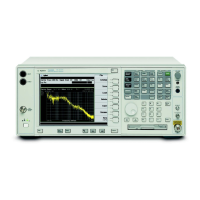368 Chapter 8
N5531S Measuring Receiver Performance Verification
Performance Verification Tests
N5531S Measuring Receiver Performance
Verification
4. Initialize the test equipment parameters as follows:
5. Both the signal source and the PSA must warm up for at least 2 hours.
6. Look at the calibration report for the step attenuator. The metrology lab that
characterized the attenuator should have listed on the report a note about which
11713A Attenuator Driver switch was activated to obtain the 40 dB data. This
is important since the 8496G has two 40 dB steps, and you must assure you
know which switch to press to enable the calibrated 40 dB step. The other 40
dB attenuator step is used only to achieve the 80 to 110 dB steps.
7. Using the step attenuator calibration data, fill in Table 8-4, “Measurement Test
Record,” Atten Calibration Value and Atten Uncert with the reference
attenuation value (the value the cal lab measured) and the measurement
uncertainty for each attenuator step.
8. Select the 0 dB setting on the step attenuator.
9. Press
Meas Setup, Set Ref key. Assure reading is 0.000 dB. If not, press Set Ref
key again.
Table 8-2 Signal Generator Settings
Parameter Setting
Frequency 50 MHz
Level +12 dBm
RF On
Table 8-3 PSA Settings
Parameter Setting
Mode Measuring Receiver
Measure Tuned RF Level
Frequency
Note: Do not use the Frequency Counter function. You
must press the
Frequency key and set the frequency
manually.
50 MHz
Accuracy
(under Meas Setup)
High
10 MHz Out
(under System, Reference)
ON
Freq Ref
(under System, Reference)
Int

